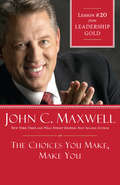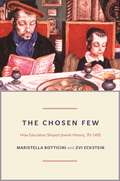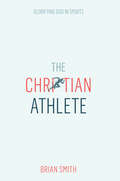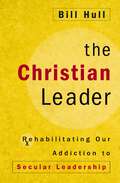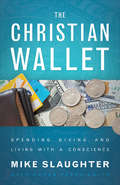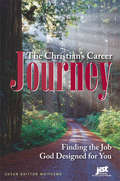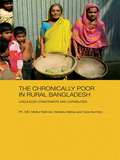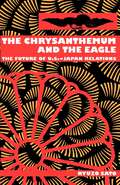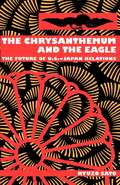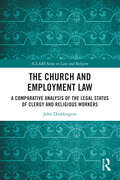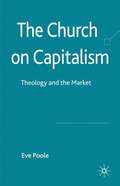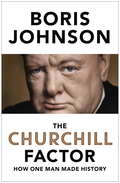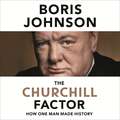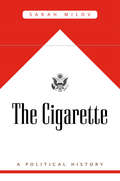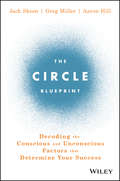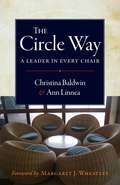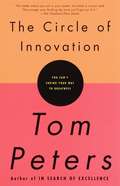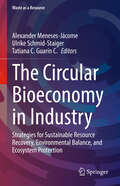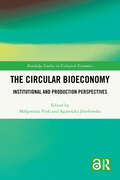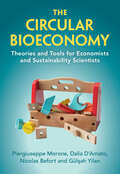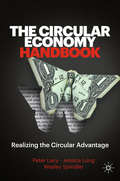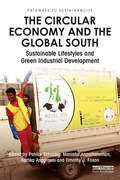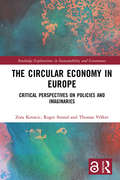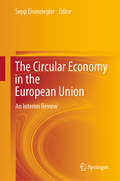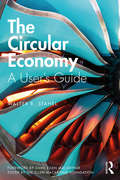- Table View
- List View
The Choices You Make, Make You
by John MaxwellSmart leaders learn from their own mistakes. Smarter ones learn from others' mistakes--and successes. John C. Maxwell wants to help you become the smartest leader you can be by sharing Chapter 20, The Choices You Make, Make You of Leadership Gold with you. After nearly forty years of leading, Maxwell has mined the gold so you don't have to. Each chapter contains detailed application exercises and a "Mentoring Moment" for leaders who desire to mentor others using the book. Gaining leadership insight is a lot like mining for gold. You don't set out to look for the dirt. You look for the nuggets. You'll find them here.
The Chosen Few: How Education Shaped Jewish History, 70-1492 (The Princeton Economic History of the Western World #42)
by Maristella Botticini Zvi EcksteinHow the Jewish people went from farmers to merchantsIn 70 CE, the Jews were an agrarian and illiterate people living mostly in the Land of Israel and Mesopotamia. By 1492 the Jewish people had become a small group of literate urbanites specializing in crafts, trade, moneylending, and medicine in hundreds of places across the Old World, from Seville to Mangalore. What caused this radical change? The Chosen Few presents a new answer to this question by applying the lens of economic analysis to the key facts of fifteen formative centuries of Jewish history. Maristella Botticini and Zvi Eckstein offer a powerful new explanation of one of the most significant transformations in Jewish history while also providing fresh insights into the growing debate about the social and economic impact of religion.
The Christian Athlete: Glorifying God in Sports
by Brian SmithThe Christian Athlete is a gospel-centered guide that assists athletes who identify as Christians and are seeking to understand how to practically apply their faith to their sport. Athletes desire—and deserve—a more substantive expression of the Christian faith in the context of sport, but they don&’t know what it looks like or where to turn to learn more. Author Brian Smith shares his story as an athlete and coach, and his experience working with high-level athletes in the last decade to help readers better understand how to integrate faith and sport by: Assisting those who want a wide-angled understanding of how to live the Christian faith in the context of sportsWalking through the many questions Christian athletes ask about winning, losing, injuries, practice, and everything in betweenMoving Christian athletes from simply having clichéd spiritual sayings decorating their bodies or t-shirts to actually living out their faith through all the opportunities their sport offers themThe Christian Athlete will show readers how to live out a biblical perspective on athletics and urge them to engage in the gifts they are given to glorify God whether they are the team MVP or riding the bench.
The Christian Leader: Rehabilitating Our Addiction to Secular Leadership
by Bill Hull Robby Gallaty<P>From the author of the best-selling book The Disciple-Making Pastor comes a call to Christian leaders to let go of their addiction to secular models of leadership rooted in pragmatic success.<P> Most leadership literature talks about having the “right kind” of leadership personality.<P> You know the type: big-picture visionaries who serve others and get the best out of people.<P> But the popular pattern of doing what works and getting rewarded for it is actually the enemy of Christian leadership. <P>It thrives on making our work impersonal and exploitive.<P> Far too often, it serves the leader rather than those the leader leads.<P> Sadly, this pattern dominates Christian leadership in the West.<P> We need a different style of leadership — one patterned after Jesus. Jesus influenced others because of who he was, not because he was well-known or a person of power or because he had mastered a set of skills or implemented an effective leadership strategy.<P> He could have completed his mission living in your house, driving your car, married to your spouse, working at your office, and raising your kids because leadership comes down to character.<P> Many who aspire to leadership are looking for the right circumstances so they can lead. <P>Many in positions of leadership find it difficult to lead because of obstacles, such as a lack of funds, authority, and or confusion about methods. Jesus faced all of these — and more — yet he accomplished his mission.<P> This is not a book about improving Christian organizations; it is about changing how Christians lead.<P> It is for anyone with a megaphone, a platform to speak, who wants to lead others in being a witness for truth. It is for people with a pulpit, whether that pulpit be a business or a position of influence in a domain of the culture: entertainment, sports, politics, industry, the arts, academia, or religion.<P> If you are someone to whom others listen— this book is for you.<P> Each chapter begins with a title and statement about Jesus’ life. <P>Jesus was a different kind of teacher.<P> The Pharisees focused on doing the right thing. Jesus emphasized becoming the kind of person who wants to do the right thing. <P>Others taught the importance of doing good; Jesus taught how to be good. <P>He didn’t teach behavior modification alone; he taught how to change the sources of behavior.<P> Knowing how to lead others begins by seeing Jesus as your leader.
The Christian Wallet: Spending, Giving, And Living With A Conscience
by Mike SlaughterEvery Christian knows that we are called to love God with all our heart, mind, soul, and strength. But what about our wallet? We are asked to open it every Sunday when the offering basket comes by and are told that giving is a way of being a "good steward," but what about spending money at a restaurant or grocery store? Best-selling author Mike Slaughter offers a comprehensive look at how Christians use their money in The Christian Wallet. Slaughter explores today's culture of consumerism and the impact of what we buy, asking difficult questions about morality and money.The Christian Wallet helps Christians grapple with important questions about stewardship: how we spend, how we live, how we save, how we give, and what it all means. Questions for individual or group study are also included with each chapter.
The Christian's Career Journey
by Susan Britton WhitcombWhether you want to work in the private sector or public sector, business or industry, corporate America or mom-and-pop shop, nonprofit or ministry organization, this book will unveil the deeper significance and purpose God has for your career.
The Chronically Poor in Rural Bangladesh: Livelihood Constraints and Capabilities (Routledge Studies in Development Economics)
by Noriatsu Matsui Yukio Ikemoto Pk. Md. RahmanThis book examines rural poverty in Bangladesh. Based on detailed empirical research and surveys of households in Bangladesh, it provides an accurate portrait of the everyday situations faced by the rural poor in Bangladesh today, covering all aspects of household behaviour. All of the key issues are explored, including health, nutrition, housing conditions, human capital, household asset and liabilities, gender issues, livelihood strategies, distribution of household income and expenditure, social capital, intergenerational mobility of the chronically poor, women’s mobility, shocks and coping strategies, and vulnerability to poverty. The book focuses in particular on the poorest of the poor households, the chronically poor, seen by many in the development community to be the core of the problem of poverty. It shows that the basic characteristics of the chronically poor households in rural Bangladesh are: more heavily female-headed households, higher dependency ratio of children in demographic composition, and dominated by lower levels of assets, shorter years of schooling and limited employment opportunity. Throughout, it draws precise conclusions on the basis of quantitative data, which makes this book an important resource for policy-makers and development practitioners, as well as students and researchers.
The Chrysanthemum and the Eagle: The Future of U.S.-Japan Relations
by Ryuzo SatoWhether in the form of the ongoing automotive wars, books and films such as Michael Crichton's Rising Sun, or George Bush's ill-fated trip to Japan in 1991, frictions between the United States and Japan have been steadily on the rise. Americans are bombarded with images of Japan's fundamental difference; at the same time, voices in Japan call for a Japan That Can Say No. If the guiding principle of the Clinton administration is indeed new values for a new generation, how will this be reflected in U.S.-Japanese relations?Convinced that no true solution to U.S.-Japanese frictions can be achieved without tracing these frictions back to their origin, Ryuzo Sato here draws on a binational experience that spans three decades in both the Japanese and American business and academic communities to do just that. In an attempt to bridge the communication gap between the two countries and dispel some of the mutual ignorance and misunderstanding that prevails between the two, Sato addresses the following questions: --Is Japan really different? --Has America's sun set?--How have conflicting views on the role of government affected U.S.-Japan relations?--What are the real differences in American and Japanese industrial policies?--What is the anatomy of U.S.-Japanese antagonisms?--What effect has the collapse of the bubble economy had on relations?--What is Japan's future course? Is it truly a technological superpower? Can it avoid international isolation? An incisive personal look at one of the most important political and economic global relationships, written by a major player in the world of international business and finance, THE CHRYSANTHEMUM AND THE EAGLE provides a readable and engaging tour of U.S.-Japan relations, past and present.
The Chrysanthemum and the Eagle: The Future of U.S.-Japan Relations (Open Access Lib And Hc Ser.)
by Ryuzo SatoWhether in the form of the ongoing automotive wars, books and films such as Michael Crichton's Rising Sun, or George Bush's ill-fated trip to Japan in 1991, frictions between the United States and Japan have been steadily on the rise. Americans are bombarded with images of Japan's fundamental difference; at the same time, voices in Japan call for a Japan That Can Say No. If the guiding principle of the Clinton administration is indeed new values for a new generation, how will this be reflected in U.S.-Japanese relations?Convinced that no true solution to U.S.-Japanese frictions can be achieved without tracing these frictions back to their origin, Ryuzo Sato here draws on a binational experience that spans three decades in both the Japanese and American business and academic communities to do just that. In an attempt to bridge the communication gap between the two countries and dispel some of the mutual ignorance and misunderstanding that prevails between the two, Sato addresses the following questions: --Is Japan really different? --Has America's sun set?--How have conflicting views on the role of government affected U.S.-Japan relations?--What are the real differences in American and Japanese industrial policies?--What is the anatomy of U.S.-Japanese antagonisms?--What effect has the collapse of the bubble economy had on relations?--What is Japan's future course? Is it truly a technological superpower? Can it avoid international isolation? An incisive personal look at one of the most important political and economic global relationships, written by a major player in the world of international business and finance, THE CHRYSANTHEMUM AND THE EAGLE provides a readable and engaging tour of U.S.-Japan relations, past and present.
The Church and Employment Law: A Comparative Analysis of The Legal Status of Clergy and Religious Workers (ICLARS Series on Law and Religion)
by John DuddingtonThis book examines the current law on the employment status of ministers of religion together with religious workers and volunteers and suggests reforms in this area of the law to meet the need for ministers to be given a degree of employment protection. It also considers the constant theme in Christian history that the clergy should not be subject to the ordinary courts and asks whether this is justified with the growth of areas such as employment law. The work questions whether it is possible to arrive at a satisfactory definition of who is a minister of religion and, along with this, who would be the employer of the minister if there was a contract of employment. Taking a comparative perspective, it evaluates the case law on the employment status of Christian and non-Christian clergy and assesses whether this shows any coherent theme or line of development. The work also considers the issue of ministerial employment status against the background of the autonomy of churches and other religious bodies from the State, together with their ecclesiology. The book will be of interest to academics and researchers working in the areas of law and religion, employment law and religious studies, together with both legal practitioners and human resources practitioners in these areas.
The Church on Capitalism
by Eve PooleAn examination of the views on capitalism of bishops, academics and business people in the Church of England. Highlighting the richness and distinctiveness of these arguments, it also points to flaws and gaps. Offering a new framework for public theology, Poole urges the Church to take its proper place in re-shaping the global economy.
The Churchill Factor: How One Man Made History
by Boris JohnsonAs the country navigates a national crisis once again, read how Britain's Prime Minister was inspired by Winston Churchill.One man can make all the difference.Now leader of the UK himself, Boris Johnson explores what makes up the 'Churchill Factor' - the singular brilliance of one of the most important leaders of the twentieth century. Taking on the myths and misconceptions along with the outsized reality, he portrays - with characteristic wit and passion - a man of multiple contradictions, contagious bravery, breath-taking eloquence, matchless strategizing and deep humanity.Fearless on the battlefield, Churchill had to be ordered by the King to stay out of action on D-Day; he embraced large-scale strategic bombing, yet hated the destruction of war and scorned politicians who had not experienced its horrors. He was a celebrated journalist, a great orator and won the Nobel Prize for Literature. He was famous for his ability to combine wining and dining with many late nights of crucial wartime decision-making. His open-mindedness made him a pioneer in healthcare, education and social welfare, though he remained incorrigibly politically incorrect. As Prime Minister Boris Johnson says, 'Churchill is the resounding human rebuttal to all who think history is the story of vast and impersonal economic forces'. Published in association with Churchill Heritage, The Churchill Factor is essential reading for anyone who wants to know what makes a great leader in a time of crisis.
The Churchill Factor: How One Man Made History
by Boris JohnsonAs the country navigates a national crisis once again, hear how Britain's Prime Minister was inspired by Winston Churchill. One man can make all the difference.Now leader of the UK himself, Boris Johnson explores what makes up the 'Churchill Factor' - the singular brilliance of one of the most important leaders of the twentieth century. Taking on the myths and misconceptions along with the outsized reality, he portrays - with characteristic wit and passion - a man of multiple contradictions, contagious bravery, breath-taking eloquence, matchless strategizing and deep humanity.Fearless on the battlefield, Churchill had to be ordered by the King to stay out of action on D-Day; he embraced large-scale strategic bombing, yet hated the destruction of war and scorned politicians who had not experienced its horrors. He was a celebrated journalist, a great orator and won the Nobel Prize for Literature. He was famous for his ability to combine wining and dining with many late nights of crucial wartime decision-making. His open-mindedness made him a pioneer in healthcare, education and social welfare, though he remained incorrigibly politically incorrect. As Prime Minister Boris Johnson says, 'Churchill is the resounding human rebuttal to all who think history is the story of vast and impersonal economic forces'. Written by Prime Minister Boris Johnson in 2014 and published in association with Churchill Heritage, The Churchill Factor is essential listening for anyone who wants to know what makes a great leader in a time of crisis.(P)2014 Hodder & Stoughton Limited
The Cigarette: A Political History
by Sarah MilovThe story of tobacco’s fortunes seems simple: science triumphed over addiction and profit. Yet the reality is more complicated—and more political. Historically it was not just bad habits but also the state that lifted the tobacco industry. What brought about change was not medical advice but organized pressure: a movement for nonsmoker’s rights.
The Circle Blueprint: Decoding the Conscious and Unconscious Factors that Determine Your Success
by Greg Miller Aaron Hill Jack SkeenA roadmap to fulfillment, with practical tools for the journey The Circle Blueprint is your personal guide to fulfillment. Are you thriving or just surviving? Are you energized, balanced, and happy? This book helps you dig to the root of the problem, and gives you a roadmap for getting your life on a more positive trajectory. You’ll begin with an honest assessment of your current situation, and the life choices that got you there; this is your Circle, and through it, almost anything becomes possible. Your Circle can be adjusted—expanded, narrowed, balanced, or thrown off-kilter—to steer your life where you want it to go. Your Circle must be tended to, and whether you realize it or not, you make these choices every single day. This book helps you define your Circle, master it, and create the life you want to live. Finding satisfaction doesn’t mean starting a whole new life, it means reshaping the one you have to keep what’s working and adjust what’s holding you back. This book gives you the tools and insight you need to make the journey, with practical exercises to guide you through each step of the way. Think about how your life choices affect your emotional well-being Map your existing Circle to your current levels of life satisfaction Expand and balance your Circle to align more closely to your vision Discover the fulfillment of living life with purpose Wanting more doesn’t mean not liking what you have, it’s simply an acknowledgment that there is room for improvement. Change is not only possible; it’s often inevitable—but it’s up to you to dictate the course of these changes. The Circle Blueprint helps you chart your path, and gives you the tools you need to reach that destination.
The Circle Way: A Leader in Every Chair
by Christina Baldwin Ann LinneaAn authoritative and accessible guide to this foundational form of collaborative decision-making Uses images, stories and step-by-step instructions to teach the basics of circle and explore it’s deeper meanings Written by two pioneers in reviving, standardizing and popularizing circle process More and more organizations are looking for alternatives to rigid, top-down hierarchy. Even the most old-school now realize that good ideas can come from anywhere and that fostering collaboration and group cohesion is vital to any healthy enterprise. But what approach can best create an environment that ensures clear speaking, compassionate listening, and the making of well-grounded decisions? The most ancient one: the circle. The circle was the form of original gathering that taught human beings how to create social patterns. All modern group processes open to collaboration or to flattening the hierarchy are based in some way on circle practices. Here two veteran practitioners offer a comprehensive guide to this foundational form of human interaction The Circle Way lays out the basics of circle conversation based on the original work of the coauthors, who have studied and standardized the essential elements of circle practice and have been implementing them in a variety of organizations for over fifteen years. It opens with a unique visual guide to circle and then presents both structure and story so that readers understand how these elements come into play and how they are interrelated and interactive. Baldwin and Linnea include detailed instructions and suggestions for getting started, setting goals, and solving conflicts. And they delve into the deeper aspects of circle, illuminating the profound transformation the process has on people who participate in it.
The Circle of Innovation: You Can't Shrink Your Way to Greatness
by Tom PetersTom Peters--brilliant, original, and perhaps the most inspiring and listened-to business thinker of our time--has a lot on his mind these days. And he wants to share it in The Circle of Innovation. The world of business is in a permanent state of flux, he argues, a state of chaos in which constant innovation is the only survival strategy--for the individual and for the organization. And he presents here a lifesaving handbook--both provocative and practical--designed to turn any organization into a perpetual innovation machine.In 400 seminars in 47 states and 22 countries in the last five years, Peters has reexamined, refined, and reinvented his views on innovation. Now he brings those seminars--and his passion--to the reader in a landmark book. It is meant, he writes, to both "terrify" and "enlighten." These are "times of matchless peril for those who fail to grasp the nettle...and times of matchless opportunity for those who do."To keep us alert, limber, and ready for action, he provokes and cajoles in chapter after chapter. Among his institutions and revelations:We Are All Michelangelos. He shows how to transform every "jobholder" into a full-fledged businessperson.All Value Comes from the Professional Services. How to convert sluggish staff units into Vital Centers of Intellectual Capital Accumulation.The System is the Solution. How to build great systems--which go far beyond nuts and bolts.Create Waves of Lust. Quality is not the automatic advantage it recently was. There is a pressing need to reverse the rising tide of product and service "commoditization."Tommy Hilfiger Knows. In a crowded marketplace, branding is far more important than ever before.It's a Woman's World. How to capitalize on the fact that women purchase/are purchasing agents for well over half of U.S. commercial and consumer goods.Little Things Are the Only Things. As the Blight of Sameness encroaches on market after market, design is often the best tool in services or manufacturing for sustainable differentiation.We're Here to Live Life Out Loud. Why transformational leaders of the future must have laser-like focus, tell the truth, and live on the lunatic fringe.The hallmarks of Tom Peters legend are an insatiable curiosity, an agile intellect, a pragmatic perspective, and an uncanny ability to gauge the global zeitgeist. These qualities are all brought to bear as Peters sets out to engage, enrage, and ultimately empower his readers, amid forces that are reshaping not only business but every aspect of human experience.
The Circular Bioeconomy in Industry: Strategies for Sustainable Resource Recovery, Environmental Balance, and Ecosystem Protection (Waste as a Resource)
by Alexander Meneses-Jácome Ulrike Schmid-Staiger Tatiana C. Guarín C.This book serves as a starting point for readers to understand the concepts of the circular economy and bioeconomy and how they can be applied to industrial processes. The notion of having eco-friendly industries is a recent development, with a growing interest in the environmental impact of industrial practices, particularly with regard to resource recovery practices for valuable nutrients and byproducts, which aligns with the circular economy and bioeconomy concepts that aim to establish a "continuous flow of materials." Currently, the focus is on studying the environmental impact and developing strategies to achieve a balance with water ecosystems for sustainable and equitable coexistence. The success of these concepts will depend on a robust framework that evaluates the environmental trade-offs and co-benefits of improving industry practices to enhance ecosystem protection. This book introduces circular economy practices in industry, along with tips, procedures, recommendations, and lessons learned.
The Circular Bioeconomy: Institutional and Production Perspectives (Routledge Studies in Ecological Economics)
by Małgorzata Pink Agnieszka JózefowskaFounded on distinct principles to the fossil fuel-based, linear economy, the sustainable, circular bioeconomy requires different social values and institutions and a better understanding of the complexity of the production process. A circular bioeconomy provides a framework for using renewable natural capital to manage land, biodiversity, food, and other industries, with the aim of improving social well-being and environmental safety.The contributors to this book analyse the evolution of the economic system towards the circular economy and bioeconomy and its place in the paradigm of sustainable development. They look at institutions and their importance for the bioeconomy and examine the question of the behaviour of market entities – enterprises and consumers – as well as the meaning of social and environmental responsibility for these entities. They also discuss the issues of the product itself: the process of creation, production, processing and the quality of the product, including its environmental impact throughout its life cycle. The authors also refer to the potential pitfalls and threats related to the implementation of the bioeconomy in both socio-economic and environmental contexts. Individual processes and phenomena are illustrated with case studies and the authors' own research.The book deliberately fosters an interdisciplinary approach founded on cooperation between economists, management specialists, agronomists, biotechnologists, chemists and soil scientists, who together underline the complexity and importance of the interdependence of the economy, society and the natural environment.
The Circular Bioeconomy: Theories And Tools For Economists And Sustainability Scientists
by Piergiuseppe Morone Dalia D’Amato Nicolas Befort Gülşah YilanThe Circular Economy Handbook: Realizing the Circular Advantage
by Jessica Long Peter Lacy Wesley SpindlerCan we align global production and consumption systems with sustainability? Can business growth actually lead to a healthier planet? Can companies innovate through the circular economy to create competitive advantage and genuine impact? Waste to Wealth proved that the emerging circular economy advantage exists – now Lacy, Long and Spindler show you how to realize it at speed and scale in The Circular Economy Handbook. We stand at a crossroads, with rising geopolitical and geo-economic tensions, massive technological change and a host of social and environmental challenges. We are pushing planetary boundaries to their limits, with climate change and threats to biodiversity and oceans as just a few examples. Significant impacts are already being felt, and both people and planet face potentially catastrophic and irreversible consequences if we don’t urgently change our global model and systems. Our current linear “take, make, waste” models of production and consumption will not be sustainable in a world of some 9 billion people by 2050, especially with ever-expanding rates of consumption. Thriving within these dynamics demands more than incremental adjustments to business-as-usual. The circular economy offers a powerful means to decouple growth from use of scarce and harmful resources, enabling greater production and consumption with fewer negative environmental impacts—at the same time, making companies more innovative and competitive. In fact, this book shows that $4.5 trillion in economic value is at stake. Delivering on the promise of a circular economy demands impact and scale, extending through value chains and, ultimately, disrupting the entire economic system. In The Circular Economy Handbook, the authors illuminate the path from insight to action, from linear to circular. With case studies, advice and practical guidance, they show leaders how to pivot towards a holistic circular organization, embedding circularity internally and delivering broad-based system change. With unique insights across business models, technologies, and industries – featuring stories and real-world examples from circular pioneers – this book is the essential guide to help companies become leaders in the movement to secure the circular economy advantage.
The Circular Economy and the Global South: Sustainable Lifestyles and Green Industrial Development (Pathways to Sustainability)
by Patrick Schröder Manisha Anantharaman Kartika Anggraeni Timothy FoxonThe circular economy is a policy approach and business strategy that aims to improve resource productivity, promote sustainable consumption and production and reduce environmental impacts. This book examines the relevance of the circular economy in the context of developing countries, something which to date is little understood. This volume highlights examples of circular economy practices in developing country contexts in relation to small and medium enterprises (SMEs), informal sector recycling and national policy approaches. It examines a broad range of case studies, including Argentina, Brazil, China, Colombia, India, Indonesia, Kenya, South Africa, and Thailand, and illustrates how the circular economy can be used as a new lens and possible solution to cross-cutting development issues of pollution and waste, employment, health, urbanisation and green industrialisation. In addition to more technical and policy oriented contributions, the book also critically discusses existing narratives and pathways of the circular economy in the global North and South, and how these differ or possibly even conflict with each other. Finally, the book critically examines under what conditions the circular economy will be able to reduce global inequalities and promote human development in the context of the Sustainable Development Goals. Presenting a unique social sciences perspective on the circular economy discourse, this book is relevant to students and scholars studying sustainability in economics, business studies, environmental politics and development studies.
The Circular Economy in Europe: Critical Perspectives on Policies and Imaginaries (Routledge Explorations in Sustainability and Governance)
by Zora Kovacic Roger Strand Thomas VölkerThe Circular Economy in Europe presents an overview and a critical discussion on how circularity is conceived, imagined, and enacted in current EU policy-making. In 2013, the idea of a circular economy entered the stage of European policy-making in the efforts to reconcile environmental and economic policy objectives. In 2019 the European Commission declared in a press release that the Circular Economy Action Plan has been delivered. The level of circularity in the European economy, however, has remained the same. Bringing together perspectives from social sciences, environmental economics and policy analysis, The Circular Economy in Europe provides a critical analysis of policies and promises of the next panacea for growth and sustainability. The authors provide a theoretical and empirical basis to discuss how contemporary societies conceive their need to re-organise production and consumption and explores the messy assemblage of institutions, actors, waste streams, biophysical flows, policy objectives, scientific disciplines, values, expectations, promises and aspirations involved. This book is essential reading for all those interested in understanding how ideas about the circular economy emerged historically, how they gained traction and are used in policy processes, and what the practical challenges in implementing this policy are.
The Circular Economy in the European Union: An Interim Review
by Sepp EisenrieglerThe implementation of the circular economy will entail a major transformation from a resource-destroying, linear economy to a circular one that operates within the planet’s regenerative boundaries. This book presents an interim assessment of the implementation of a circular economy in the EU. It reveals what achievements have been made in various EU institutions, but which are scarcely perceived by the public; which basic scientific principles can be applied in this context; and what NGOs are demanding beyond this progress. It provides convincing arguments for abandoning the “hamster wheel” of material-based satisfaction of our needs, and shows that the primacy of the economy stands in the way of a good life for all. Given its focus, it will appeal to everyone interested in an ecologically sustainable economic system.
The Circular Economy: A User's Guide
by Walter R StahelA Circular Economy seeks to rebuild capital, whether this is financial, manufactured, human, social or natural, and offers opportunities and solutions for all organisations. This book, written by Walter Stahel, who is widely recognised as one of the key people who formulated the concept of the Circular Economy, is the perfect introduction for anyone wanting to quickly get up to speed with this vitally important topic for ensuring sustainable development. It sets out a new framework that refines the concept of a Circular Economy and how it can be applied at industrial levels. This concise book presents the key themes for busy managers and policymakers and some of the newest thinking on the topic of the Circular Economy from one of the leading thinkers in the field. Practical examples and case studies with real-life data are used to elucidate the ideas presented within the book.
